7 Types of Furniture Your Dog Will Destroy, Experts Say
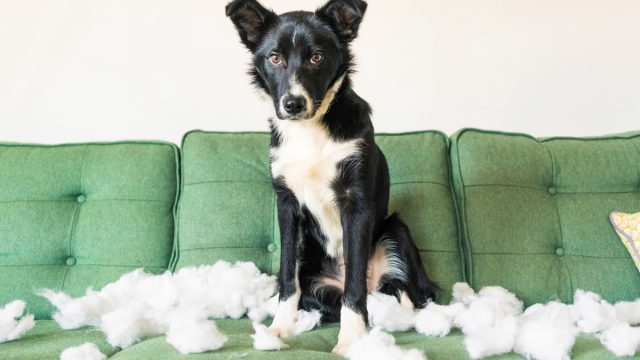
While we may believe our sweet pooch is perfectly trained or that our new puppy is too small to do any real damage, it’s still good to do some research before ending up with a living room anchored by a hair-covered, expensive velvet mistake. Certain fabrics are too tempting to scratch, while particular furniture pieces can prove a safety hazard. To find out what types of furniture your four-legged friend is most likely to destroy, we consulted dog experts and design pros. Read on to learn what dog parents should avoid–and what choices are up to the task.
READ THIS NEXT: 5 Low-Maintenance Dogs You Barely Need to Walk.
1
Velvet and other luxe fabrics
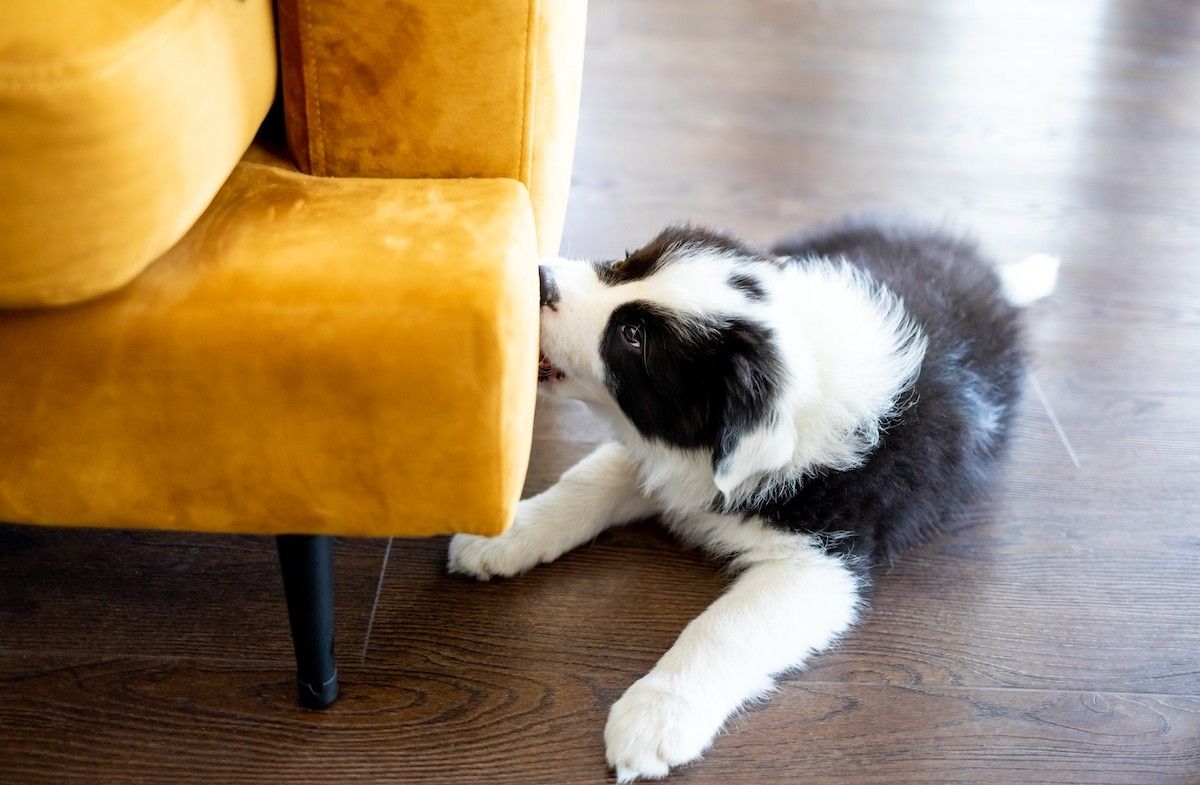
Though velvet upholstery, whether antique or modern in style, is a designer favorite, this plush fabric is a magnet for pet hair, is easily destroyed, and can be challenging to clean and repair. Many other luxe fabrics pose similar problems.
“Unquestionably, the worst textiles to have in your home if you have cats and dogs are silk, velvet, linen, suede, and tweed. In addition to being delicate and/or prone to snagging, most of these materials can’t withstand water or the enzymatic cleaners that are typically suggested for cleaning up pet stains,” explains Leonardo Gomez, CEO of Runball, a company that sells dog treats and toys.
Jen Stark, founder of Happy DIY Home, concurs. “Cleaning dog hair from furniture is one issue that arises when you have dogs. Avoid using materials like corduroy, mohair, velvet, or chenille that are prone to attracting pet hair.” And when choosing a hue, keep the color of your pet in mind. You don’t want to buy a black sofa if you have a fluffy white dog.
2
Leather (sometimes)

Opinions are divided on this popular sofa and armchair material. How it will work for you as a dog owner depends (as with marble countertops) on how much you like the “patina” the natural material gets with wear and tear.
Though it may wipe clean more easily than fabric, leather is no match for puppy nails and teeth. According to Daniel Cargill, co-founder of The Dog Tale, leather furniture comes with some basic instructions to keep it looking great, and these can be a challenge if you have a dog. “For example, you never want to get leather wet. Doing so can pull oils out of the leather and create splotches and stains that ruin that smooth, supple look. Now picture your dog coming in from the rain, after a romp in the morning dew, or after playing in the snow.”
Cargill also notes that dogs’ nails will inevitably scuff up the leather, which might be acceptable for some. “I’d encourage you to just view it as adding to the well-weathered look leather adopts over time,” he says.
On the other hand, leather is fairly tough and can be a dream if you have a very hairy dog. “If your dog sheds a lot, you won’t want a sofa that is hard to clean. Materials like leather and canvas work really well when it comes to cleaning up messes and removing unwanted fur,” says Linda Simon, veterinary surgeon and consultant at FiveBarks.
READ THIS NEXT: If Your Dog Is Playing With This, Take it Away Immediately.
3
White covers

Just like it’s wise to avoid wearing white when eating a pasta dinner, you may want to skip light-colored fabrics if you’re a dog owner. “Last year my wife bought a white bedspread,” says Cargill. “We made the bed, stepped back, and looked at how bright and clean it made our bedroom look. Then our dog hopped up on the bed. We had recently taken him for a walk in the park, and he immediately stained the fabric with his paws. We tried to clean the dirty marks, but they just kept coming day after day.”
Like your favorite white t-shirt, white fabrics can also yellow and fade over time, especially if you’re constantly treating stains. Instead, choose darker tones like charcoal, olive, or, at the lightest, dark beige. You can also look for washable fabrics that are made to be thrown in the laundry.
And if all else fails, invest in a nice dog bed that you place adjacent to the couch, this way your dog can be comfortable and still be near you.
4
Wooden legs
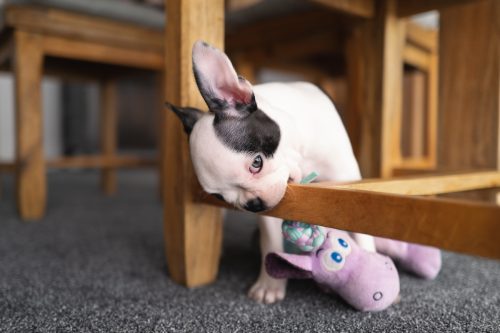
Dogs—especially teething puppies—love to chew. “Pups explore the world with their mouths,” says Simon, which makes wooden table or chair legs prime chew toys. Metal or plastic are less desirable materials for your dog. Of course, wood can be impossible to avoid. In these cases, be sure you put out plenty of other chew-friendly toys or rawhides.
5
Dog-level coffee tables
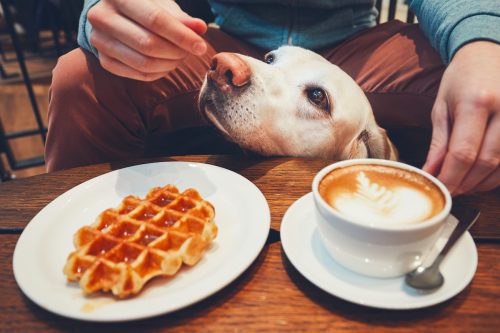
You’ve probably heard about toddler-level coffee tables being dangerous when children start walking. The same principle applies to dogs, though it’s less about them hitting their heads and more about the messes that can ensue. “A glass of red wine will go flying onto the sofa or rug with one wag from a happy pup,” says Reya Duenas of Reya Duenas Design.
Similarly, low drink stands can be problematic, as they’re typically much lighter and balanced on one thin leg. Be sure these weigh enough to stay put and try to set them on an even floor, not a rug.
For more pet content delivered straight to your inbox, sign up for our daily newsletter.
6
Anything with small or movable parts
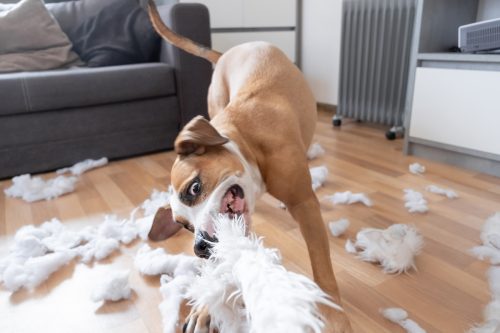
Look out for furniture with small or movable parts. Dogs may chew off or swallow them, which could lead to choking or intestinal blockages, according to Jeff Netzley, founder of Dog Training Near You. “This could include buttons, zippers, removable cushions, or decorative elements like tassels or beads.” These decorative elements are also tempting to swat and play with, which could lead your dog to ruin a fun pillow or embellished curtain.
7
Reclining armchairs

This is less about your dog destroying the chair and more about how it can hurt them. Corinne Wigfall, veterinarian and spokesperson for online dog training resource SpiritDog Training, cautions dog owners that reclining armchair accidents are more common than most people realize. “As a veterinarian, I have seen many accidents where dogs (or kittens) have [had] limbs or a tail trapped in the metal workings of these chairs when the footstool is released, or crushed when placed back down or the chair reclined.” Opt instead for a stand-alone ottoman or footrest that you can place in front of a stationary chair.
When in doubt, Jaquelyn Kennedy, canine behavioral specialist and founder of PetDT, suggests avoiding anything expensive or fragile. “When you have a dog, you should avoid having furniture that is overly expensive, fancy, or fragile. Even a highly trained dog will sometimes get excited and jump on the furniture, and this means that the furniture gets dirty, scratched, and sometimes even bitten!”